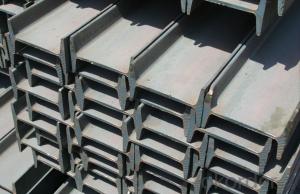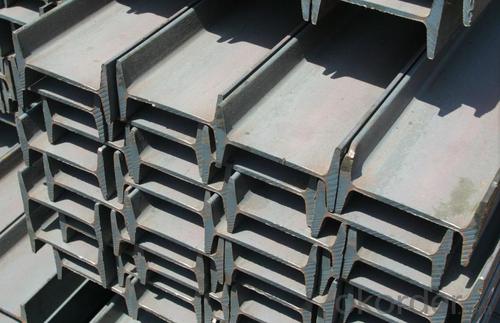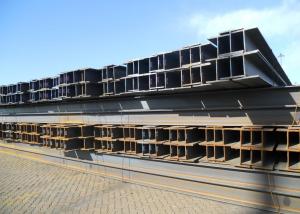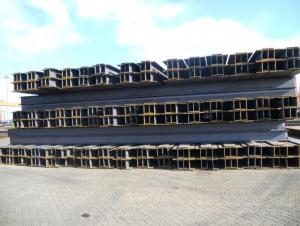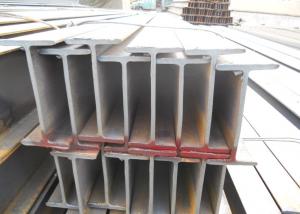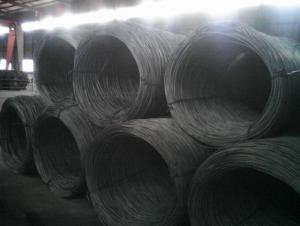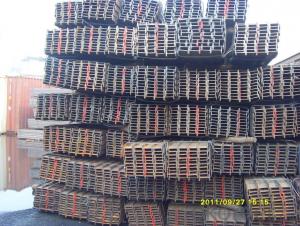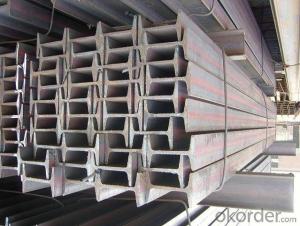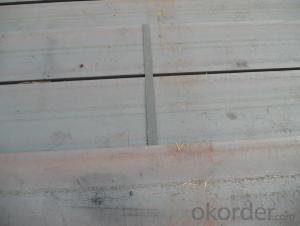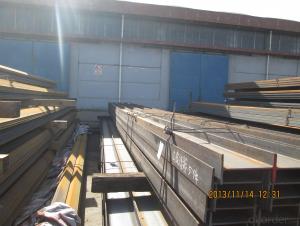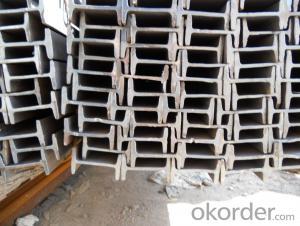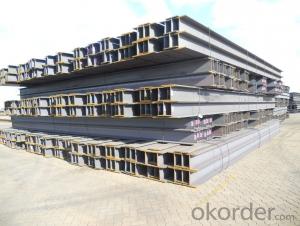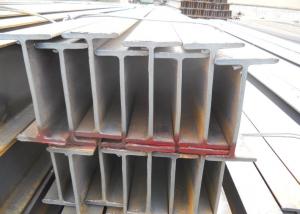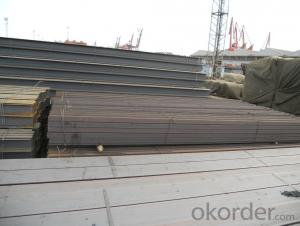High Quality Low Carbon H Beams for Structure
- Loading Port:
- China Main Port
- Payment Terms:
- TT or LC
- Min Order Qty:
- 100 m.t.
- Supply Capability:
- 10000 m.t./month
OKorder Service Pledge
OKorder Financial Service
You Might Also Like
Product Description:
OKorder is offering High Quality Low Carbon H Beams for Structure at great prices with worldwide shipping. Our supplier is a world-class manufacturer of steel, with our products utilized the world over. OKorder annually supplies products to African, South American and Asian markets. We provide quotations within 24 hours of receiving an inquiry and guarantee competitive prices.
Product Applications:
High Quality Low Carbon H Beams for Structure are ideal for structural applications and are widely used in the plant, high-rise building construction; the bridge, shipment building; lifting and transportation machinery, equipment manufacturing base building; the support, foundation pile manufacturing
Product Advantages:
OKorder's High Quality Low Carbon H Beams for Structure are durable, strong, and wide variety of sizes.
Main Product Features:
· Premium quality
· Prompt delivery & seaworthy packing (30 days after receiving deposit)
· Can be recycled and reused
· Mill test certification
· Professional Service
· Competitive pricing
Product Specifications:
Manufacture: Hot rolled
Grade: Q195 – 235
Certificates: ISO, SGS, BV, CIQ
Length: 12m, as per customer request
Packaging: Export packing, nude packing, bundled
| H BEAM | ||||||
| size | h (MM) | b (MM) | t1 (MM) | t2 (MM) | Mass: Kg/m | LENGTH |
| 100x100 | 100 | 100 | 6.0 | 8 | 16.9 | 12M |
| 125x125 | 125 | 125 | 6.5 | 9 | 23.6 | 12M |
| 150x75 | 150 | 75 | 5.0 | 7 | 14.0 | 12M |
| 148x100 | 148 | 100 | 6.0 | 9 | 20.7 | 12M |
| 150x150 | 150 | 150 | 7.0 | 10 | 31.1 | 12M |
| 175x90 | 175 | 90 | 5.0 | 8 | 18.0 | 12M |
| 175x175 | 175 | 175 | 5.0 | 11 | 40.4 | 12M |
| 198x99 | 198 | 99 | 4.5 | 7 | 17.8 | 12M |
| 200x100 | 200 | 100 | 5.5 | 8 | 20.9 | 12M |
| 194x150 | 194 | 150 | 6.0 | 9 | 29.9 | 12M |
| 200x200 | 200 | 200 | 8.0 | 12 | 49.9 | 12M |
| 200x204 | 200 | 204 | 12.0 | 12 | 56.2 | 12M |
| 248x124 | 248 | 124 | 5.0 | 8 | 25.1 | 12M |
| 250x125 | 250 | 125 | 6.0 | 9 | 29.0 | 12M |
| 244x175 | 244 | 175 | 7.0 | 11 | 43.6 | 12M |
| 250x250 | 250 | 250 | 9.0 | 14 | 71.8 | 12M |
| 250x255 | 250 | 255 | 14.0 | 14 | 81.6 | 12M |
| 298x149 | 298 | 149 | 5.5 | 8 | 32.0 | 12M |
| 300x150 | 300 | 150 | 6.5 | 9 | 36.7 | 12M |
| 294x200 | 294 | 200 | 8.0 | 12 | 55.8 | 12M |
| 294x302 | 294 | 302 | 12.0 | 12 | 83.4 | 12M |
| 300x300 | 300 | 300 | 10.0 | 15 | 93.0 | 12M |
| 300x305 | 300 | 305 | 15.0 | 15 | 105.0 | 12M |
| 346x174 | 346 | 174 | 6.0 | 9 | 41.2 | 12M |
| 350x175 | 350 | 175 | 7.0 | 11 | 49.4 | 12M |
| 340x250 | 340 | 250 | 9.0 | 14 | 78.1 | 12M |
| 344x348 | 344 | 348 | 10.0 | 16 | 113.0 | 12M |
| 350x350 | 350 | 350 | 12.0 | 19 | 135.0 | 12M |
| 396x199 | 396 | 199 | 7.0 | 11 | 56.1 | 12M |
| 400x200 | 400 | 200 | 8.0 | 13 | 65.4 | 12M |
| 400x300 | 400 | 300 | 10.0 | 16 | 105 | 12M |
| 388x402 | 388 | 402 | 15.0 | 15 | 140 | 12M |
| 394x398 | 394 | 398 | 11.0 | 18 | 147 | 12M |
| 400x400 | 400 | 400 | 13.0 | 21 | 172 | 12M |
| 400x408 | 400 | 408 | 21.0 | 21 | 197 | 12M |
| 414x405 | 414 | 405 | 18 | 28 | 232 | 12M |
| 428x407 | 428 | 407 | 20 | 35 | 283 | 12M |
| 458x417 | 458 | 417 | 30 | 50 | 415 | 12M |
| 498x432 | 498 | 432 | 45 | 70 | 605 | 12M |
| 446x199 | 446 | 199 | 8 | 12 | 65.1 | 12M |
| 450x200 | 450 | 200 | 9 | 14 | 74.9 | 12M |
| 440x300 | 440 | 300 | 11 | 18 | 121 | 12M |
| 496x199 | 496 | 199 | 9 | 14 | 77.9 | 12M |
| 500x200 | 500 | 200 | 10 | 16 | 88.2 | 12M |
| 506x201 | 506 | 201 | 11 | 19 | 102 | 12M |
| 482x300 | 482 | 300 | 11 | 15 | 111 | 12M |
| 488x300 | 488 | 300 | 11 | 18 | 125 | 12M |
| 596x199 | 596 | 199 | 10 | 15 | 92.5 | 12M |
| 600x200 | 600 | 200 | 11 | 17 | 103 | 12M |
| 606x201 | 606 | 201 | 12 | 20 | 118 | 12M |
| 582x300 | 582 | 300 | 12 | 17 | 133 | 12M |
| 588x300 | 588 | 300 | 12 | 20 | 147 | 12M |
| 594x302 | 594 | 302 | 14 | 23 | 170 | 12M |
| 692x300 | 692 | 300 | 13 | 20 | 163 | 12M |
| 700x300 | 700 | 300 | 13 | 24 | 182 | 12M |
| 792x300 | 792 | 300 | 14 | 22 | 188 | 12M |
| 800x300 | 800 | 300 | 14 | 26 | 207 | 12M |
| 890x299 | 890 | 299 | 15 | 23 | 210 | 12M |
| 900x300 | 900 | 300 | 16 | 28 | 240 | 12M |
| 912x302 | 912 | 302 | 18 | 34 | 283 | 12M |
FAQ:
Q1: Why buy Materials & Equipment from OKorder.com?
A1: All products offered byOKorder.com are carefully selected from China's most reliable manufacturing enterprises. Through its ISO certifications, OKorder.com adheres to the highest standards and a commitment to supply chain safety and customer satisfaction.
Q2: How many tons of steel products could be loaded in containers?
A2: Usually the steel products are delivered by bulk vessel because of the large quantity and the freight. However, there are no bulk vessel enter some seaports so that we have to deliver the cargo by containers. The 6m steel product can be loaded in 20FT container, but the quantity is changed according to the size, usually from 18tons to 25tons.
Q3: How soon can we receive the product after purchase?
A3: Within three days of placing an order, we will arrange production. The normal sizes with the normal grade can be produced within one month. The specific shipping date is dependent upon international and government factors, the delivery to international main port about 45-60days.
Images:
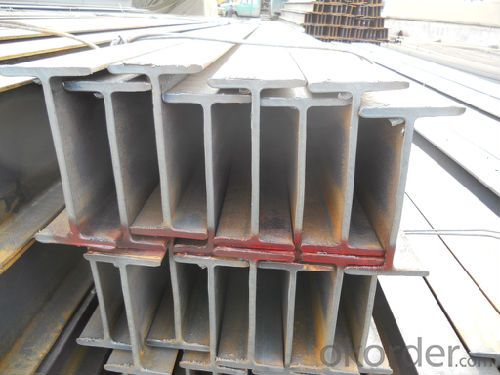

- Q: Can steel H-beams be used for supporting elevated walkways or platforms?
- Yes, steel H-beams can be used for supporting elevated walkways or platforms. The structural strength and load-bearing capacity of H-beams make them suitable for such applications.
- Q: Can steel H-beams be used for religious buildings?
- Yes, steel H-beams can be used for religious buildings. Steel H-beams are widely used in construction due to their strength, durability, and versatility. They provide structural support and can be used for various applications, including religious buildings such as churches, mosques, temples, or synagogues. These beams can support the weight of the roof, walls, and other architectural elements, ensuring the stability and safety of the structure. Additionally, steel H-beams can be customized and fabricated to meet the unique design requirements of religious buildings, allowing for intricate designs and flexible layouts. Therefore, steel H-beams are a suitable choice for constructing religious buildings.
- Q: What are the different types of steel H-beam connections used in residential buildings?
- There are several different types of steel H-beam connections commonly used in residential buildings. These connections are designed to provide stability and strength to the overall structure. Here are a few examples: 1. Welded Connection: This is one of the most common types of connections used in residential buildings. In this method, the H-beam is welded directly to the supporting structure, such as columns or beams, using high-strength welding techniques. Welded connections provide excellent strength and rigidity, making them suitable for applications that require heavy loads or high lateral forces. 2. Bolted Connection: Bolted connections involve using high-strength bolts to connect the H-beam to the supporting structure. This method offers ease of installation and allows for easy disassembly or modification if needed. Bolted connections are commonly used in situations where the H-beam needs to be adjustable or removable, such as in mezzanine floors or temporary structures. 3. Shear Plate Connection: This type of connection utilizes steel plates placed on either side of the H-beam, which are then bolted together. The plates help distribute the load from the beam to the supporting structure, providing excellent strength and stability. Shear plate connections are commonly used in situations where the H-beam needs to resist heavy loads or moments. 4. Clip Angle Connection: Clip angle connections involve using steel angles that are welded to both the H-beam and the supporting structure. These angles provide additional support and rigidity to the connection. Clip angle connections are commonly used in situations where the H-beam needs to resist lateral loads or uplift forces. 5. Moment Connection: Moment connections are designed to resist rotational forces or moments. These connections involve using a combination of welding and bolting techniques to ensure a rigid and strong connection between the H-beam and the supporting structure. Moment connections are commonly used in situations where the H-beam needs to support large cantilevered structures or heavy loads. It is important to note that the specific type of steel H-beam connection used in a residential building will depend on various factors, such as the load requirements, the architectural design, and the structural engineer's recommendations.
- Q: How do steel H-beams contribute to the load-bearing capacity of a structure?
- Steel H-beams contribute to the load-bearing capacity of a structure by providing strength and support. These beams are designed to withstand heavy loads and distribute them evenly, making them ideal for carrying the weight of floors, walls, and roof systems. The H-shape of the beam allows for a higher strength-to-weight ratio, which means it can support more weight without being excessively heavy itself. Additionally, the wide flanges of the H-beam provide stability and prevent buckling, ensuring the overall structural integrity of the building.
- Q: How do steel H-beams compare to wooden beams in terms of strength?
- Steel H-beams are significantly stronger than wooden beams in terms of strength. Steel has a much higher strength-to-weight ratio than wood, allowing H-beams to support heavier loads and resist deformation or structural failure more effectively. Additionally, steel beams exhibit better resistance to moisture, fire, and pests compared to wooden beams.
- Q: Can steel H-beams be used in the construction of commercial buildings?
- Indeed, the utilization of steel H-beams is feasible for the erection of commercial buildings. In the realm of construction, steel H-beams are widely employed owing to their remarkable strength-to-weight ratio, endurance, and adaptability. These beams serve as a crucial foundation, ensuring the stability and structural integrity of buildings, rendering them appropriate for commercial purposes. Moreover, steel H-beams are accessible in various dimensions and can be custom-made to fulfill precise building requisites. This flexibility enables the efficient and economical construction of commercial buildings, hence establishing steel H-beams as a sought-after preference within the industry.
- Q: What is the length of the butt joint of H steel? What is the minimum requirement?
- No, just on the basis of the docking process.
- Q: Are there any standards or codes that govern the use of steel H-beams?
- Steel H-beams are governed by a variety of standards and codes. One well-known standard is the AISC specification, which provides guidelines for designing, fabricating, and erecting structural steel. This specification outlines requirements for H-beams, including dimensions, strength, and connection details. In the United States, the IBC is a widely accepted set of regulations that establishes minimum requirements for building design and construction. It references industry standards, including the AISC specification, to ensure the safe and efficient use of structural steel, including H-beams. Different countries have their own specific standards and codes for steel H-beams. For example, Europe commonly uses the Eurocode system, which offers a unified set of design codes for various construction materials, including steel. The Eurocodes address specific provisions for H-beams, such as material properties, design principles, and construction details. Engineers, architects, and construction professionals must be familiar with these standards and codes when using steel H-beams to ensure compliance with safety, performance, and quality requirements. Following these standards helps maintain the integrity and stability of structures, enhancing safety and longevity in the built environment.
- Q: How do steel H-beams compare to concrete beams in terms of construction speed?
- Steel H-beams are generally faster to construct compared to concrete beams. This is primarily due to the lighter weight of steel beams, which allows for easier transportation and installation. Steel beams can be prefabricated off-site, reducing on-site construction time. In contrast, concrete beams require more time for formwork, curing, and other construction processes. Overall, steel H-beams offer a quicker construction process, making them a popular choice in many construction projects.
- Q: How do steel H-beams perform in areas with high seismic activity?
- Steel H-beams are widely recognized for their superior performance in areas with high seismic activity. The structural design of H-beams allows them to effectively absorb and dissipate seismic energy, making them highly resilient to earthquakes. One key factor contributing to the excellent performance of steel H-beams in seismic areas is their inherent strength and stiffness. H-beams are made of high-strength steel, which can withstand significant forces and deformations without collapsing or losing integrity. This strength helps minimize damage to the structure and ensures the safety of occupants. Moreover, the shape of H-beams provides an added advantage in seismic regions. The horizontal flanges and vertical web of the beam work together to distribute the seismic loads evenly across the structure. This distribution of forces helps prevent localized stress concentrations and reduces the likelihood of structural failure during an earthquake. Additionally, steel H-beams can be designed to incorporate connections that offer enhanced seismic resistance. These connections are designed to allow for some flexibility and rotation, enabling the beams to accommodate the movement and deformation caused by seismic activity. This flexibility helps dissipate the seismic energy and minimizes potential damage to the building. Furthermore, steel is inherently ductile, meaning it can undergo significant deformation before failing. This ductility is crucial in seismic areas, as it allows the steel H-beams to absorb and dissipate seismic energy by undergoing controlled deformations. This ability to absorb energy helps protect the overall structure and ensures the safety of the occupants. In conclusion, steel H-beams are an excellent choice for areas with high seismic activity. Their strength, stiffness, and ductility make them highly resilient to seismic forces, enabling them to effectively absorb and dissipate seismic energy. The design and shape of H-beams, along with their connections, further enhance their performance in seismic regions. Ultimately, steel H-beams provide a reliable and safe structural solution in areas prone to earthquakes.
Send your message to us
High Quality Low Carbon H Beams for Structure
- Loading Port:
- China Main Port
- Payment Terms:
- TT or LC
- Min Order Qty:
- 100 m.t.
- Supply Capability:
- 10000 m.t./month
OKorder Service Pledge
OKorder Financial Service
Similar products
Hot products
Hot Searches
Related keywords
